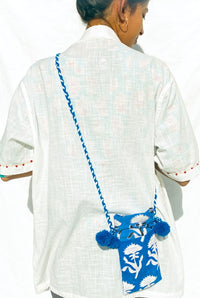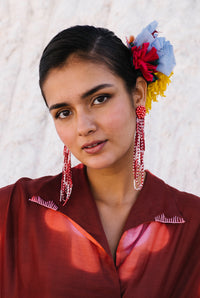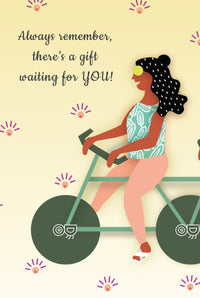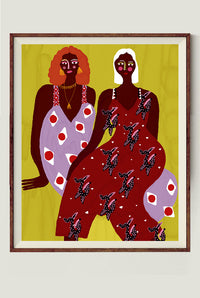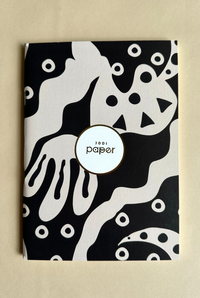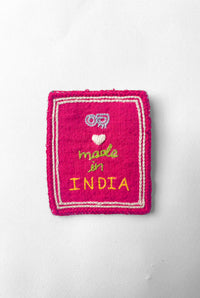A Brief Conversation With Studio Wood

In the summer of 2014, four young designers came together to create a capsule collection of furniture pieces, made by deconstructing old sample pieces. This self curated exhibit birthed into immediate existence the young, but focused architecture/interior design studio : Studio Wood. The show was an instant success, that led to their first architecture-interior project. Six years on, the team has condensed further into the seasoned partnership between Navya Aggarwal & Vrinda Mathur. Here we speak to the two of them about their work and design philosophies.
What is one best and worst thing about working in a partnership?
The best thing is that you’re never alone. The brunt of every idea (good or bad), every mistake is taken up by a team and not by oneself. This road of entrepreneurship (which began at an early age of 23 for us) had many unforeseen situations for which we relied on each other. But having a partner means having different opinions and views on a single subject. And while both points of view are laid out, only one is taken forward. This means that you can’t always have your way. It’s very similar to a marriage (right?)
Navya wears the Afreen Silk Sari. Vrinda wears the Gulaal Silk Sari
What have been your key learnings in trying to develop a design process together? Could you speak to us about your design philosophy?
Since both, Vrinda & I studied at the same design school (NIFT, Delhi) a lot of the processes we practice today stem from the same core. We begin with design research of materials & techniques, go on to doodling and then brainstorming. We study each others sketches, interpret them in our own manner and develop ideas keeping the whole process open & collaborative in nature. Most products are conceptualised by one and refined by the other, keeping up with the SW way of designing. While every furniture collection greatly differs from the other, one constant remains designing for the young (at heart) and restless with in-the-moment aesthetics and ingenious quirks

Along with commissioned interior design projects, you also develop furniture. How is working on both of these different?
All our interior & commissioned furniture projects have an end client, a defined brief already laid out before us. Our self-curated furniture exhibitions is where we go with the flow unescorted by a list of directives. An internal brief is established based on many factors that interest us as individuals. Sometimes it’s a colour we are obsessing over, a new material we want to experiment with or simply a doodle we want to see come alive. These collections are a literal translation of ‘having fun at your own expense’ and we make sure to live up to that bit of the brief. 
We love how you've done up your office. What was the inspiration behind the space?
When we started out in 2014, we worked out of a small room at the factory. Cut to, two years later when we found a beautifully lit corner plot in the same village and decided to make it our HQ. As designers, we wanted the space to reflect our work, ethos and personalities and here we were dealing with three very versatile ones - Navya, Sahej and myself (the three co-founders). Our aim was to make the space a flexible one, a creative studio by day and a space for ‘beer' and ‘Dear’ Friday's by night. The open plan office is zoned into three main spaces; A display space at the entrance followed by a metal partitioned meeting room and then the main workspace. A small pantry and the washroom are placed behind a brick partition. We consciously chose to work with repurposed materials such as scrap metal pieces, cut pieces of ply, wood and other samples to create the walls in the meeting room. For the walls of the studio, we simply chipped the plaster and repainted the texture that appeared below in white which added to the openness of the space. The highlights have to be our knick knacks - an old Godrej fridge from Sahej’s which we painted in blue that now houses our stationery, souvenirs from Navya’s travels, postcards and tit bits from friends, artworks, plants and objects rummaged from our sites.
Studio Wood HQ
How do you decide when something you've created is 'working' or 'not working'?
While in a business ‘working’ and ‘not working’ maybe a translation of the sales numbers, we must look beyond statistics and focus on the intangible aspects in the long term. You can get immediate feedback on design- how people interact with products and spaces is a way of understanding the success of a design.
We are presently living bang in the middle of a pandemic. One of the biggest changes for each of us has been the enforcement of living just within our personal spaces for long periods of time. One is definitely seeing the impact of this on our collective thought processes. How do you think space affects our moods?
We are confined within four walls and are currently performing different activities within the realm of our homes. Each of us have a unique way of functioning, some enjoy energy while others prefer the calm, some favour a homely feel at work while others would rather keep the home disassociated from work. The experience of a space leads to the mood you’ll create for yourself. An amalgamation of textures, lighting and volume of objects help you perceive your room the way you wish to, creating a frame of mind you wish to function in.
Navya wears the Tarana Tiered Dress. Vrinda wears the Madhubani Silk Dress.
What inspires the both of you?
As entrepreneurs, inspiration and motivation run concurrently; One has to constantly fight their internal battles and outshine, get out of bed to conquer the day ahead and the possibilities of how the day will unfold, inspires. A shorter, less philosophical answer - Inspiration comes from a fulfilling day at the studio, good music, rain. Also, validation.
You are located in an urban village of sorts. How interesting! Villages have their own existing social framework. What was your experience like setting up shop here?
Since our furniture workshop was located in Kishangarh, a small urban village in the south of Delhi, we wanted to be in close proximity for regular quality checks, production supervision and interaction with the team. Kishangarh, compared to other urban villages such as Shahpur Jat, Khirki or Chattarpur has not developed in terms of an influx of creative studios or cafes. It stands majorly populated by the locals in addition to homes rented by North East Indians, small-medium scale offices and warehouses and a very small number of foreigners. In an attempt to blend in the everydayness of the village, we, as a group of young designers and thinkers wanted to start a dialogue with the local population. For this very reason, we conceptualised the ‘You For Us’ initiative. The project involved for us to gain an understanding of the different activities that dominate the village; small time vendors, ration shops, boutiques, barbers, churches, temples, mosques etc. After days of research scurrying along the narrow lanes of Kishangarh, we decided to create a map of the area on our studio’s facade. Over many full days and weekends with the help of our team, volunteers and the local kids we created our own version of Google Maps; Technology like Google Maps while on one hand promotes convenient way finding, it inadvertently also omits elements with smaller footprints. In contexts like those of urban villages these micro activities and spaces trump the smartphone led methodology of interactive wayfinding. Over the last three years, this artistic expression has lead to many conversations and interactions with the community at large.
For young designers who are starting out in your industry, what advice would you give them?
Our business is guided by two distinct yet kindred fields, furniture design and interior design. Both require a certain set of skills, experience and contextual understanding. That said, when we started out back in 2014, we too were a group of fresh design graduates united by an eagerness to build something new, something different. My one piece of advice would be: Find your voice. 
What are you working on at the moment?
In the pre-lock down era, we were working on a myriad of things at the studio - An office space using sustainable materials, a sample showroom for bikes, a retail space for wall finishes and final touches for a contemporary home in the capital. In the midst of the lockdown, we got an opportunity to take a step back, introspect, make plans for the future of our practise and its people. While a typical day is packed with team calls on zoom, updates and live chats on Instagram and never ending accounts work we are working towards a branding makeover for Studio Wood!
Navya wears the Jameela Dress. Vrinda wears the Zeenath Sheath Dress.
What is the strangest brief you've ever been given?
This one was sometime in 2016 ‘designing an ice-cream truck’! A one of it’s kind space -the truck, and one that sells those fancy nitro-cones and what not. While the brief wasn’t particularly strange, just envisioning a space within a vehicle and not walls was a head scratcher!
What is your favourite project to date and why?
My most favourite project has to be Re-love. Before Studio Wood, when we all (the cofounders) came together to simply create; No client brief, no real experience. Just a bunch of young design enthusiasts trying their hands at something new. If it weren’t for those early days of brainstorming, factory visits, market sourcing and hot chocolate fudge breaks who knows if we would’ve reached where we are today, both professionally and personally.
How do you see technology shaping interior design in the near future?
In 2020, we’re already in a time where digital design and rendering tools have superseded manually drafted drawings and sketches. Personally, my process starts on paper through doodles, mind maps and interactions with the team and not on the new age softwares. Howbeit, in order to constantly evolve, technology supports in better presentation, detailing and is often indefectible. Softwares and apps are becoming grossly intuitive which help both the designer and consumer in communication and perception.
Photographs by Aditi Gupta

